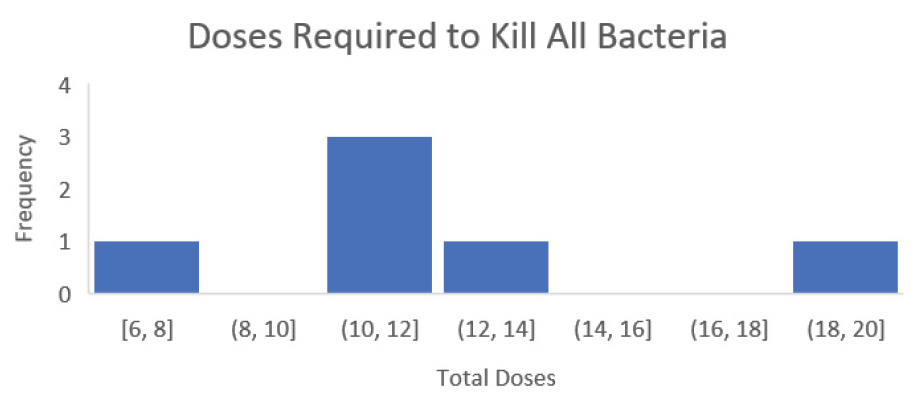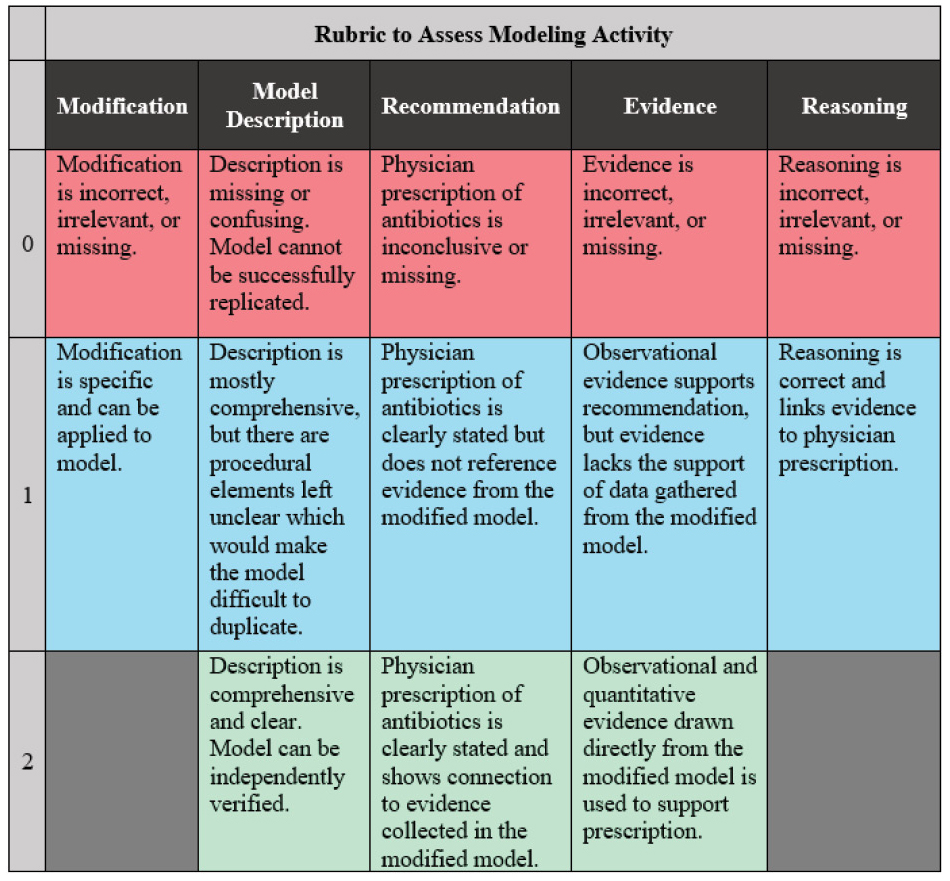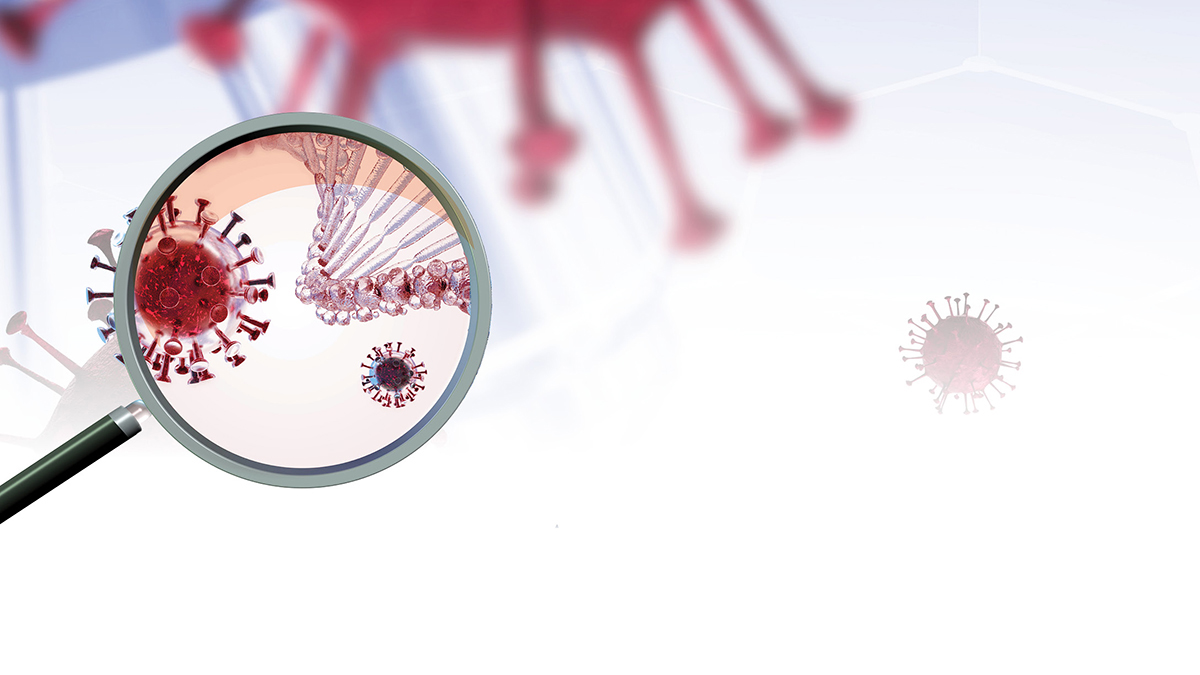special issue
An Evolution in Teaching Natural Selection
Modeling Antibiotic Resistance
Biodiversity on Earth is staggering, and ecologists have only begun the enormous task of documenting all the unique species of plants and animals in existence. However, within the diversity of life’s varied shapes, sizes, and mechanisms, there exists an underlying continuity of biochemical machinery in forms of RNA and DNA. One explanation addresses this harmony between the unity and diversity in life: Organic diversity is a response to environmental diversity through evolution. Indeed, “nothing in biology makes sense except in the light of evolution” (Dobzhansky 1973).
As such, the biological evolution of a population is one of the “big ideas” in biology, represented by the NGSS disciplinary core idea MS/HS.LS4 (Biological Evolution: Unity and Diversity). However, the acceptance of this idea is “atypically low for a developed nation,” and although acceptance has been increasing over the past decade, it remains “low in international rankings” at 54% during the years 2019–2020 (Miller et al. 2021). Not surprisingly, it is also one of the least understood topics in high school biology, and students often develop many misconceptions about the process. Students rarely notice the impact of individual variation on the process of natural selection and “often view evolution as the adaptation of individuals rather than populations” (Sandoval and Reiser 2004). Additionally, schools commonly emphasize microevolutionary mechanisms, but students “still have a poor understanding of processes which operate at the macro level” such as speciation (Catley 2006).
Envisioning evolution
Evolution, as it is typically presented, often appears as a theoretical concept, which makes it difficult for students to discover this topic in more meaningful ways. Teachers need to prioritize inquiry and give students a chance to discover the process of evolution through direct observation and investigation. An interactive modeling activity allows students to investigate a threat to modern medicine and a modern example of evolution in action: antibiotic-resistant bacteria.
Antibiotic resistance has been a steady occurrence since the original 1928 discovery of the penicillin mold by Alexander Fleming. Infections caused by antibiotic-resistant bacteria threaten medical procedures and treatment of people during surgery, with chronic conditions, after organ transplants, undergoing dialysis, and receiving cancer treatments (Centers for Diseease Control and Prevention [CDC] 2019a). Antibiotics are also a commonplace treatment in farm operations, and “6.1 million kilograms of medically important antibiotics [were] sold to US farmers in 2019” (Dall 2020). Rampant antibiotic resistance poses distinct threats to our agricultural and farming operations, affecting access to a safe food supply and our environment (CDC 2019b). Overall, antibiotic resistance has created an “alarming situation,” and efforts employing a more judicious use of antibiotics are required to delay further emergence of resistant bacteria (Economou and Gousia 2015).
Modeling the process of natural selection contributing to antibiotic resistance will develop students’ understanding of evolutionary principles and target common misconceptions through hands-on interactions. Students will manipulate and revise physical models of bacterial populations being treated with antibiotics (science and engineering practice (SEP) developing and using models). Students will also construct an explanation for the mechanism that creates antibiotic resistance within populations of bacteria (crosscutting concept cause and effect, SEP constructing an explanation).
The activity is designed for two consecutive class periods of high school students in a general biology or introductory ecology course. It’s recommended to conduct the lesson at the introduction of a unit on evolution, as antibiotics and related antibiotic resistance fit well in this context. This lesson also helps familiarize students with the structure and function of prokaryotic cells.
Classroom requirements and materials
- Board and marker/chalk
- Projection and speaker capabilities
- Video of bacterial lysis by penicillin
- Video excerpt of TED talk discussing an anecdote of life before antibiotics
- Video excerpt of PBS case study on Addie’s antibiotic-resistant infection
- Notecards
- A bowl; 80 white, six-sided dice; and 5 colored dice per group
- Students should be seated in groups of four to have partners for think-pair-share and groups for hands-on modeling.
Notice and wonder
The lesson began with an unlabeled model of a prokaryotic cell projected onto the board. If a projector is unavailable, students could receive individual copies of this model. When students enter the classroom, they should complete a notice and wonder chart on a piece of notebook paper. Students often notice that the model depicts a cell that has hair and a tail. They might also notice that it has some organelles inside. Depending on their prior exposure to prokaryotic cells, they might wonder why the cell has hair and why there is a tangle of lines inside the cell.
During this time, the teacher walked around the room to gauge student familiarity with prokaryotic cells. These observations helped determine how much content review to conduct. After students addressed their notice and wonder charts, some students were selected to share what they noticed with the class. Since a significant proportion of students struggled with recalling the structure of prokaryotic cells, a labeled eukaryotic cell diagram was projected beside the prokaryotic cell diagram. As a class, students brainstormed the functions of the new cell structures they observed in the prokaryote by comparing the two diagrams. Students then drew their own model of the prokaryote on their notice and wonder chart and added the newly defined cell structures to their diagram.
The teacher emphasized that there is a 3:1 ratio of microbial to human cells in our bodies and that we as people are surrounded by microbes. Students then participated in a think-pair-share with the following prompts:
- What do bacteria need to live and grow?
- Predict where in this classroom you would find the highest number of bacterial populations.
- Propose a location where bacteria cannot grow.
Preview
Following the review, a TED talk video excerpt discussing a personal anecdote of deadly infections before antibiotics was used to establish meaning and context for the lesson that followed. The video segues from bacteria to an introduction to antibiotics. Supporting instruction broke down some of the ideas included in the video. The word antibiotic was structurally analyzed by breaking up the word parts anti- and biotics to create a comparable definition of “against living things.” Depending on student needs, other topics of the video, such as how quickly the infected got ill, how hard it would have been as a nurse not being able to help an infected person, and how dangerous injuries were for people before antibiotics, were discussed.
Students were engaged in thought and discussion through think-pair-share structures, which included applications of the video and the use of antibiotics using the questions below:
- What do antibiotics do? (Students mistakenly generalized that antibiotics stopped infection. It was clarified that antibiotics treat bacterial not viral infections.)
- Have you or someone you know had to take antibiotics?
- When might you be most susceptible to an infection?
- Where might you be most likely to get an infection?
Observing and developing ideas
With antibiotics introduced, the discussion transitioned to consider the mechanisms of antibiotics with the following questions:
- How do you think antibiotics work?
- How could we figure this out?
- What tools or technology might we be able to use to observe bacteria treated with penicillin?
The teacher described the origin of the antibiotic penicillin, which began in 1928 when Alexander Fleming discovered the antibiotic effects of Penicillium mold. While watching a video, students observed E. coli cultures, which were untreated and treated with penicillin. Students were challenged to identify these cultures. These observations were shared in response to the following questions:
- What did you observe in the video?
- How did the E. coli act differently?
- Which side was the population treated with penicillin? Justify your answer.
- What part of the cell is affected by “bursting” or lysis?
- How does the antibiotic penicillin kill bacteria?
Following the discussion, students were engaged in a think-pair-share strategy to discuss possible pros and cons of antibiotic use to preview the case study video. They were then shown a video case study of Addie, a girl who became infected with antibiotic-resistant bacteria. If students needed note-taking support, they were provided with a transcript.
A timeline activity was included after the video to help support students in identifying the main ideas of the video. Students used notecards and worked in groups to identify key events, putting these events on individual cards. Students ordered the cards in chronological order to create a timeline. These group timelines were used to compile a class timeline for all students to reference on the main board. Students used this compiled timeline to generate main ideas, which were written on the board. The teacher used guiding questions when necessary to prompt student participation and reveal key themes like resistant bacteria, evolution, and natural selection.
Hands-on modeling
Finally, students explored and interacted with the process of natural selection. The teacher related the chance a bacterium is resistant to probability and introduced dice as a tool to represent how antibiotic resistance develops within a population. Students were provided with a foundational structure for the model and given a table to reference during the modeling exercise (Figure 1). White dice were “susceptible” and would be killed by a dose of antibiotic if they rolled a 1, 2, 3, 4, or 5. Colored dice were “resistant” and would only be killed if they rolled a 6. Students could “administer a dose of antibiotics” by rolling all the dice. The teacher guided students in using their tables to calculate the probability of survival for both susceptible and resistant dice.

Modeling antibiotic treatment of bacteria.
The teacher demonstrated how to roll the dice by gently dumping them out of a bowl and modeled how to sort dice into “dead” and “surviving” groups. Students were guided to identify important variables, such as the number of doses given, the number of dice that “survive” each dose, and the proportion of survivors from each type of dice. As students defined these quantitative variables, the variables were listed on the board. Students determined whether each variable was independent or dependent. Students correctly identified the doses of antibiotics as the independent variable that they were changing. The total “surviving” dice and the proportion of survivors were determined to be dependent variables, as they changed in response to the doses given. The teacher then modeled how to arrange these variables in a data table (Figure 2). Once these parameters were instilled, students received a set of 85 dice and a bowl to create their models.

Bacterial response to antibiotics.
Much potential confusion was mitigated through the initial demonstration. After students had killed all their bacteria dice, they shared their observations and data as a class to develop conclusions. Some of the following questions might be used to facilitate discussion:
- How many doses were given before each type of bacteria dice were killed?
- How did the bacteria dice population change over time?
- Were there any outliers in these observations?
- How did the proportion of survivors from each type of dice change throughout the course of the model? What was it at the beginning? At the end?
- What title could we give to our data table to reflect some of the trends that we observed?
As students share their data during this discussion, the teacher can use it to demonstrate the creation of graphical, quantitative evidence such as the histogram shown in Figure 3. If time permits, students can perform more trials to collect a better data spread. After the teacher has shared how graphs can be used to make more sense of observations, the discussion concluded with more reflective questions and prompts, which placed a focus on some of the unrealistic assumptions of the model:

Tracking doses needed to kill all bacteria.
- Would we always start with the same number of resistant bacteria?
- Predict what would happen if you stopped taking antibiotics early.
- If these were real bacteria instead of dice, what might we observe in between doses?
Application
Students shared a range of ideas about the differences between the dice model and the real world: real bacteria would multiply; some bacteria might have moderate resistance and a different probability of survival; a different, stronger antibiotic might be given; and bacteria may experience mutations, which create resistance. With these ideas, the teacher introduced a driving question for students to examine: How can this model of bacterial evolution be modified to be more accurate?
Students remained in their groups to develop their own models including another consideration, which makes it more realistic. They were tasked with writing about their design to allow an independent verification of their findings. They were also challenged to apply their model in the position of a medical professional prescribing antibiotics to a patient. Students were reminded that excessive antibiotic prescription would be undesirable because of the increased risk of developing antibiotic resistance. Students had the option of creating reports or presentations to share these outcomes. Student outcomes were assessed per prespecified rubric criteria provided in Figure 4.

Rubric to assess modeling activity.
Extension activities
Once students have observed antibiotic resistance in their models, this topic can be explored further with a lab component. The Next Generation Science Storylines Project outlines an experiment that can be run over the course of multiple days and gives students valuable experiences plating and observing bacterial colonies in the presence of antibiotics. Lab 5a and 5b thoroughly explain lab safety procedures and materials needed to give students another opportunity to learn about the interactions of antibiotics and bacteria (Next Generation Science Storylines 2017).
Reflection
This lesson provided students with an initial experience of using models to explain observed phenomena and then challenged them to use evidence from their observations to refine the design of the model within a cooperative learning environment. Students formed a strong base upon which to develop their understanding of the natural process of evolution throughout the rest of the unit. Simultaneously, they were given an opportunity to develop an awareness of how to use a variety of observational evidence to inform an investigation. This awareness is useful as students applied their understanding of science to the world around them.
Online Connections
Video of bacterial lysis by penicillin: https://www.youtube.com/watch?v=UjLmf-cVcMw.
TED talk discussing an anecdote of life before antibiotics: https://www.youtube.com/watch?v=o3oDpCb7VqI.
Hunting the Nightmare Bacteria video: www.pbs.org/video/hunting-nightmare-bacteria-update-nqil1d/
Kadi Hogan (kadihogan@gmail.com) is a graduate student in education at Wichita State University, Wichita, KS.
Biology Crosscutting Concepts Disciplinary Core Ideas Evolution Inquiry Instructional Materials Lesson Plans Life Science NGSS Phenomena Research Science and Engineering Practices Teaching Strategies High School



